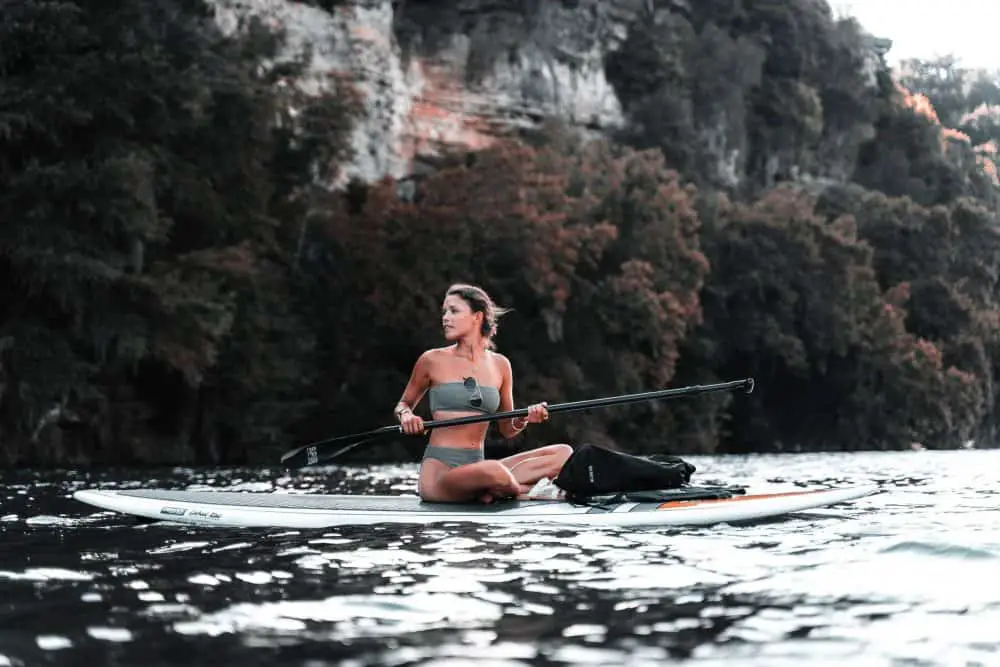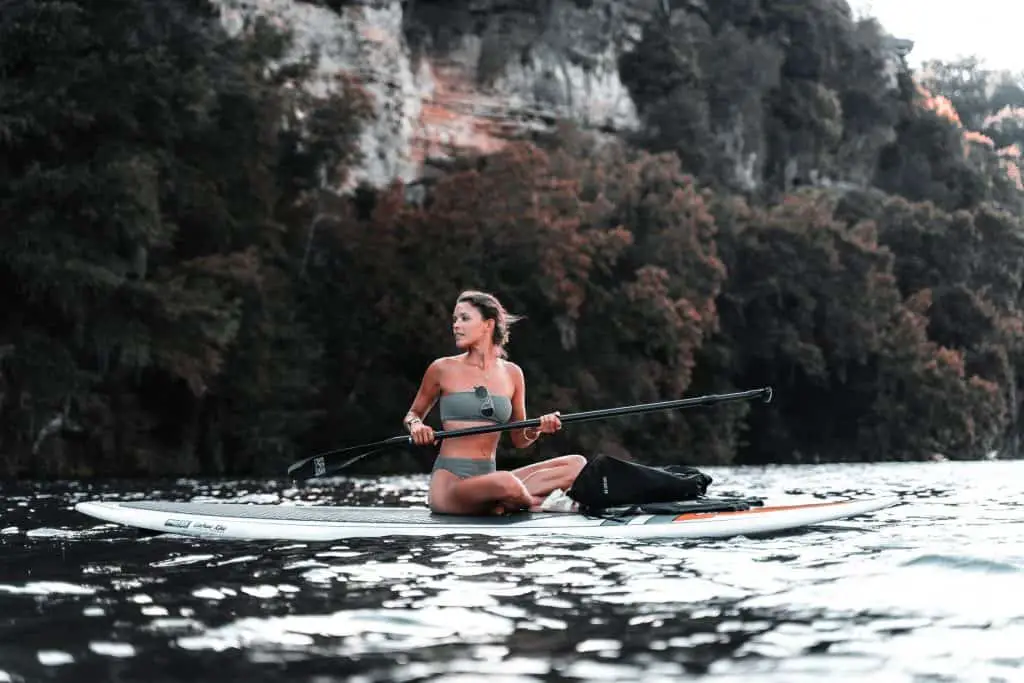As an Amazon Associate we earn from qualifying purchases.
Paddleboarding, and stand-up paddleboard is not a difficult water sport to learn.
You can easily become an expert paddler in no time at all. It is suitable for all fitness types and all ages. All you need is practice and instruction.
Paddleboarding is easy enough to learn, and it also gives you the opportunity to get a full-body work out while being outside in the fresh air.

What we want to know is how hard is it to learn this water-sport. Is learning paddleboarding difficult, or can it really be as easy as breathing?
Table of Contents
How to Paddleboard
Paddleboarding is no over-exerting challenge. With a few steps you can paddle like a pro in no time at all. You should be mindful of a few things before you jump up on that board and get out onto the open water though.
First of all, if this is your first time, you need to have an appropriate board, start off with a beginner paddle board because they offer more stability, and they will be easier for you to learn on.
You should also start learning in a location where the waters are calm and flat, a lake in the morning or the evening is best, with minimal winds and chop.
For the same reason you should avoid learning in the ocean, oceans are choppy and have higher winds, save ocean paddleboarding until after you have mastered the board.
It may take you a few tries to stand up. Remember that you are standing on a board on top of water, you will have to gain and maintain balance.
So, don’t worry if it takes you a few tries to get it right.
Step-by-Step Paddleboarding
- Before you head out onto the water, you need to ensure that your paddle is sized correctly. If you are SUP paddleboarding then you should have a paddle that it at least a foot taller than you are.
- When you enter the water with your paddle and paddleboard you should clear the fins from any sand or debris from shallow waters.
- Kneeling down, with one knee on your paddleboard, push off to launch into the water.
- Before you stand up on your board, make sure that you are comfortable kneeling. It will help you get your balance better.
- Once you feel more comfortable and balanced in your kneeling position, you can stand up, take it slowly and steadily. There is no rush.
- Place your paddle perpendicular before you on your board.
- To start standing, place your hands on your board for extra stability.
- Then place your feet, one by one shoulder width apart at the center of your board. There is a center grab handle which is a fantastic point to use as reference for the best balance, and efficiency for paddling.
- Make sure that you grab your paddle as you stand, you will need that.
- Continue practicing standing up on your board until you feel comfortable and confident doing so. You’ve got this!
What are the most common mistakes?
Like with anything, you can make some mistakes. When it comes to paddleboarding, you can always make a mistake here or there if you do not know that it is a mistake.
Beginners in paddleboarding may often make mistakes that can make standing up comfortably on your paddleboard more difficult.
- Improper holding of the paddle. When you hold the paddle, the blade angle should be held toward the front of the board.
- Too much or not enough movement. You should begin at a 45-degree angle in front of your body and pull it back toward your ankle as you paddle.
- Standing properly. Be sure that your feet are shoulder width apart, or slightly more. Never less.
- Leaning. Make sure you stand up straight and look ahead, not down, if you lean forwards your balance will suffer.
- Standing up too early. You should not stand unless your board is moving in the water.
- Falling onto the board. If you fall, aim for the water not the board, you can hurt yourself falling onto your board.
- Blade in water depth. A majority of the paddle blade should be submerged, be mindful it is not too deep or too shallow.
- Losing the board. Like with surfers, you should always wear an ankle leash to prevent your board from wandering off if you fall.
- Static board. Make sure you choose the correct board for your weight, otherwise you may have difficulty moving it forward
Board to Body Match
When investing in a paddleboard you need to consider yourself as well as what you want from a board. The board needs to match you.
Manufacturers of paddleboards rate their boards based on weight limits. The idea is that the more surface area the board has, the more weight it can carry. So, a person who is heavier will need a longer and wider board than a lighter weight person.
As an idea, lets see some of the figures.
|
Length of board |
Weight range of persons |
|
9ft |
Less than 50 lbs |
|
9ft to 10ft6in |
50-125 lbs |
|
10ft6in to 11ft6in |
125-150 lbs |
|
11ft6in to 12ft6in |
150 to 225 lbs |
|
12ft6in + |
225 lbs + |
These are not strict rules, but a good idea on the weight ranges. You should be sure to check the manufacturer’s weight recommendations before you buy a paddleboard to make sure that it is the right fit for you. You should also include the weight of your life vest and paddle in this weight so that it is more accurate.
Overall Difficulty of Paddleboarding
Stand-up paddleboarding is not difficult if you have the proper equipment and get the right practices in. It may look effortless when you watch someone else do it on the water, but it does require a degree of physical fitness.
So it is wise to train yourself a little to get yourself used to the physical requirements.
That being said, whatever your fitness level is, you will do best with a board suited to your body.
Amazon and the Amazon logo are trademarks of Amazon.com, Inc, or its affiliates.

